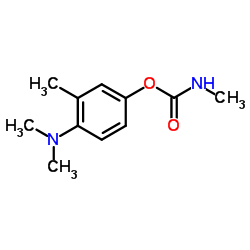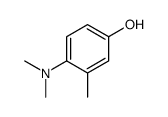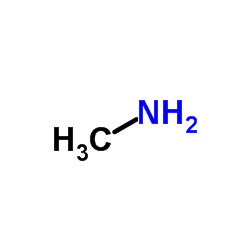Aminocarb

Aminocarb structure
|
Common Name | Aminocarb | ||
|---|---|---|---|---|
| CAS Number | 2032-59-9 | Molecular Weight | 208.257 | |
| Density | 1.1±0.1 g/cm3 | Boiling Point | 307.3±42.0 °C at 760 mmHg | |
| Molecular Formula | C11H16N2O2 | Melting Point | 93-94ºC | |
| MSDS | USA | Flash Point | 139.7±27.9 °C | |
| Symbol |


GHS06, GHS09 |
Signal Word | Danger | |
Use of AminocarbAminocarb Aminocarb is an carbamate insecticide widely used to protect cotton fields, crop fields, and forests from insect infestation. It helps in the control of aphids, soil mollusks, lepidopterous larvae, and other types of chewing insects. |
| Name | aminocarb |
|---|---|
| Synonym | More Synonyms |
| Density | 1.1±0.1 g/cm3 |
|---|---|
| Boiling Point | 307.3±42.0 °C at 760 mmHg |
| Melting Point | 93-94ºC |
| Molecular Formula | C11H16N2O2 |
| Molecular Weight | 208.257 |
| Flash Point | 139.7±27.9 °C |
| Exact Mass | 208.121185 |
| PSA | 41.57000 |
| LogP | 2.01 |
| Vapour Pressure | 0.0±0.7 mmHg at 25°C |
| Index of Refraction | 1.547 |
| InChIKey | IMIDOCRTMDIQIJ-UHFFFAOYSA-N |
| SMILES | CNC(=O)Oc1ccc(N(C)C)c(C)c1 |
CHEMICAL IDENTIFICATION
HEALTH HAZARD DATAACUTE TOXICITY DATA
MUTATION DATA
|
| Symbol |


GHS06, GHS09 |
|---|---|
| Signal Word | Danger |
| Hazard Statements | H301 + H311-H410 |
| Precautionary Statements | P273-P280-P301 + P310-P312-P501 |
| Personal Protective Equipment | dust mask type N95 (US);Eyeshields;Faceshields;Gloves;type P2 (EN 143) respirator cartridges |
| Hazard Codes | T: Toxic;N: Dangerous for the environment; |
| Risk Phrases | 24/25-50/53 |
| Safety Phrases | S28;S45;S60;S61;S36/S37 |
| RIDADR | UN 2757 |
| RTECS | FC0175000 |
| Packaging Group | II |
| Hazard Class | 6.1(a) |
| HS Code | 2924199090 |
| Precursor 0 | |
|---|---|
| DownStream 3 | |
| HS Code | 2924199090 |
|---|---|
| Summary | 2924199090. other acyclic amides (including acyclic carbamates) and their derivatives; salts thereof. VAT:17.0%. Tax rebate rate:13.0%. . MFN tariff:6.5%. General tariff:30.0% |
|
Mining biologically-active molecules for inhibitors of fatty acid amide hydrolase (FAAH): Identification of phenmedipham and amperozide as FAAH inhibitors
Bioorg. Med. Chem. Lett. 19 , 6793-6, (2009) The screening of known medicinal agents against new biological targets has been shown to be a valuable approach for revealing new pharmacology of marketed compounds. Recently, carbamate, urea and keto... |
|
|
Influence of formulation properties on droplet spectra and soil residues of aminocarb aerial sprays in conifer forests.
J. Environ. Sci. Health B 20(2) , 167-86, (1985) The influence of formulation properties on spray droplet spectra and soil residues was studied in conifer forests in New Brunswick following aerial application of two oil-based aminocarb formulations ... |
|
|
Photolysis of pesticides: influence of epicuticular waxes from Persica laevis DC on the photodegradation in the solid phase of aminocarb, methiocarb and fenthion.
Pest Manag. Sci. 57(6) , 522-6, (2001) Pesticides with N,N-dimethyl and thiomethyl moieties (aminocarb, methiocarb and fenthion) were irradiated under artificial light (lambda > 290 nm) in an amorphous wax phase from Persica laevis DC. The... |
| Mitacil |
| Aminocarb |
| Matacil 180D |
| Bayer 5080 |
| 4-dimethylamino-3-methyl-phenyl N-methylcarbamate |
| 3-methyl-4-dimethylaminophenyl N-methylcarbamate |
| [4-(dimethylamino)-3-methylphenyl] N-methylcarbamate |
| Matacil |
| Caswell No. 360 |
| MFCD00055440 |
| 4-(Dimethylamino)-3-methylphenyl methylcarbamate |
| 4-Dimethylamino-m-tolyl Methylcarbamate |
| 4-(dimethylamino)-3-methylphenyl N-methylcarbamate |
| Phenol, 4-(dimethylamino)-3-methyl-, methylcarbamate (ester) |
| EINECS 217-990-7 |
 CAS#:124-38-9
CAS#:124-38-9 CAS#:14143-25-0
CAS#:14143-25-0 CAS#:74-89-5
CAS#:74-89-5